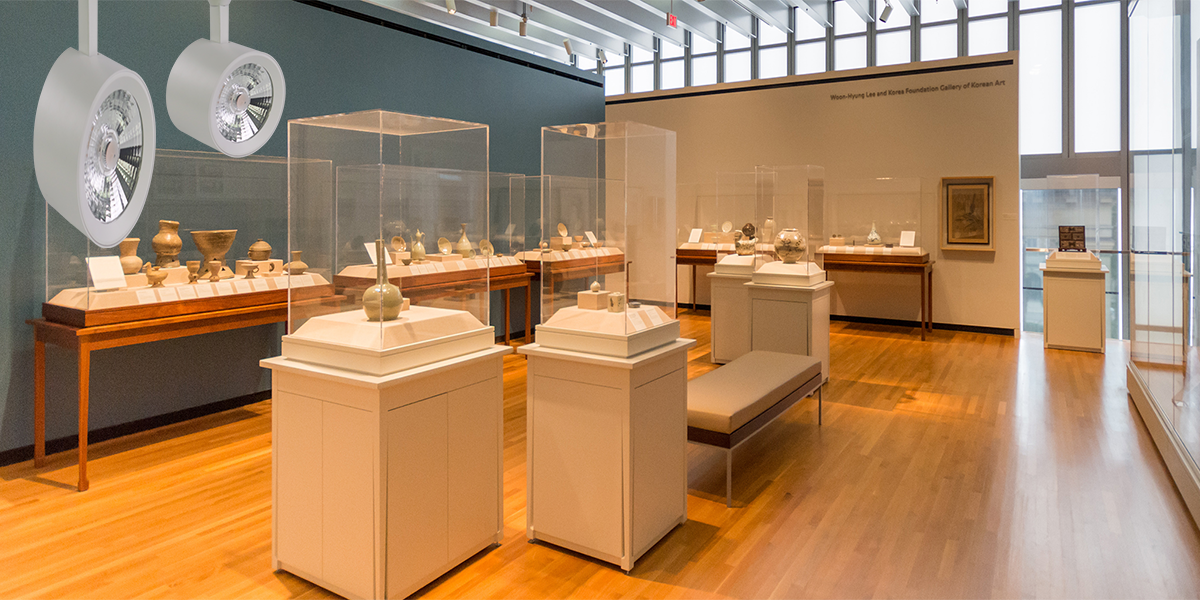LED lighting of museums and art galleries is carefully designed, strategically emphasizing brightness in specific areas and dimness in others. Since t he purpose of the space is to highlight the image and artistic value of the pieces on display, as well as to create an immersive experience with the public. Lighting design for these spaces should prioritize thoughtful placement and variation in brightness to optimize visual impact and focal point clarity.
1. Faithful expression of color and texture
The lighting of exhibition hall should be able to faithfully express the color and texture of the work, and make the work look three-dimensional. In addition, the work must be prevented from being damaged by the ultraviolet or infrared rays emitted by the light source. If you want to faithfully express colors and textures, it is best to use a light source with high color rendering.
2. Display products reasonably
A museum’s interior arrangement and the placement of artifacts are never permanent. Museum management frequently updates their exhibits, rotates artifacts, and introduces new displays, requiring a lighting system that can adapt accordingly. Typically lighting in exhibition spaces is divided into three parts: Ambient light, Accent lighting, Mixed lighting
Ambient lighting
Regardless of local special needs, the lighting method used to illuminate the entire interior. In order to improve the illuminance of a specific work area, general lighting by partition is often used. According to the layout of the indoor work area, the lighting fixtures are centrally or partitioned above the work area to ensure the illuminance of the work area, and the illuminance of the non-work area is appropriately reduced to 1/3 to 1/5 of the work area. General lighting is composed of several lighting lamps symmetrically arranged on the ceiling, which can obtain better brightness distribution and illumination uniformity indoors. Mostly led linear lights or magnetic track lighting systems are widely used.
Accent lighting
In order to meet the special needs of certain parts of the room, the lighting mode of the lighting fixtures is set within a certain range. The local lighting method is often used in the following occasions, for example, the local needs high illumination, the general lighting cannot illuminate certain areas due to occlusion, and the reflected glare in the work area needs to be reduced, in order to strengthen the lighting in a certain direction to enhance the building materialistic. you can choose the high CRI led track lights or recessed wall washer downlights.

Mixed lighting
Hybrid lighting is a combination of general lighting and local lighting in a certain working area to ensure proper visual working conditions. A well-mixed lighting method can achieve: increase the illumination of the working area, reduce the shadow and light spot on the working surface, obtain higher illumination on the vertical and inclined surfaces, reduce the total power of lighting facilities, and save energy. Mixed lighting is a lighting method composed of general lighting and local lighting.
3. Factors to Consider While Choosing the Lights
Natural Lighting
Incorporating natural light creates a connection with the outside world. Plus, it is excellent in terms of rendering colors. However, it is unstable and hard to control at one point, and the intensity of sunlight changes throughout the day. Most importantly, the damaging UV rays are not good for the museum exhibits. Therefore, artificial lighting is the most prevalent in museums and art galleries
Artificial Lighting
Lumens
The number of lumens to choose in museum lighting depends on various factors, including the size of the space, the type of exhibits, and the desired lighting levels.The lumens should be customized according o the nature of the artifact.
Color temperature
The color temperature of a light source indicates whether it emits a warm or cool color. It is measured in units called Kelvin (K).
Warm colors are associated with lower color temperatures, typically ranging from 2700K to 3500K. Warm lighting is often used to create a cozy and inviting ambiance.
Cool colors are associated with higher color temperatures, typically ranging from 4000K to 6500K or higher. Cool lighting is often used for focused and bright illumination.
For example, if the museum primarily showcases historical artifacts or traditional art, a warmer color temperature can provide a more traditional and intimate feel. On the other hand, if the museum focuses on contemporary or modern art, cooler color temperatures may enhance the visual clarity and bring out the details.
CRI
Color rendering plays a huge role in museum lighting. The paintings and photographs showcased in exhibition spaces require lighting with CRI close to daylight for the best display of colors. The closer it is to 100%, the more realistic the color of the object displayed will be.
Conclusion
With the right balance of illumination, colors, CRI, brightness levels, and types of luminaires, you can create a visually stunning design while reducing operational costs and minimizing damage to valuable artwork. that allows visitors to learn, appreciate and engage with the exhibits.